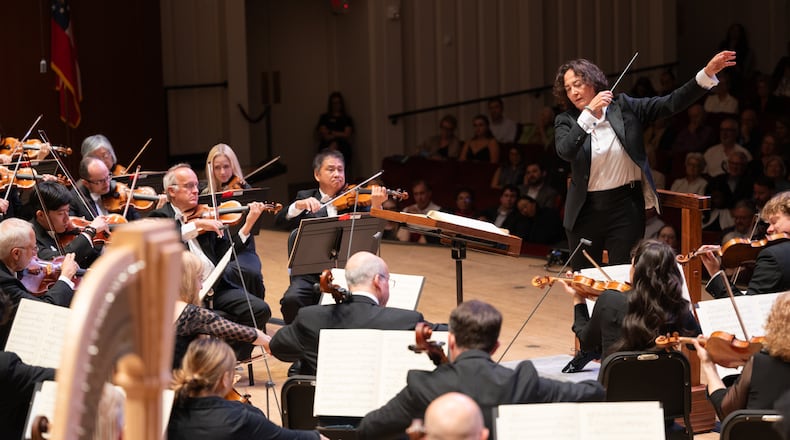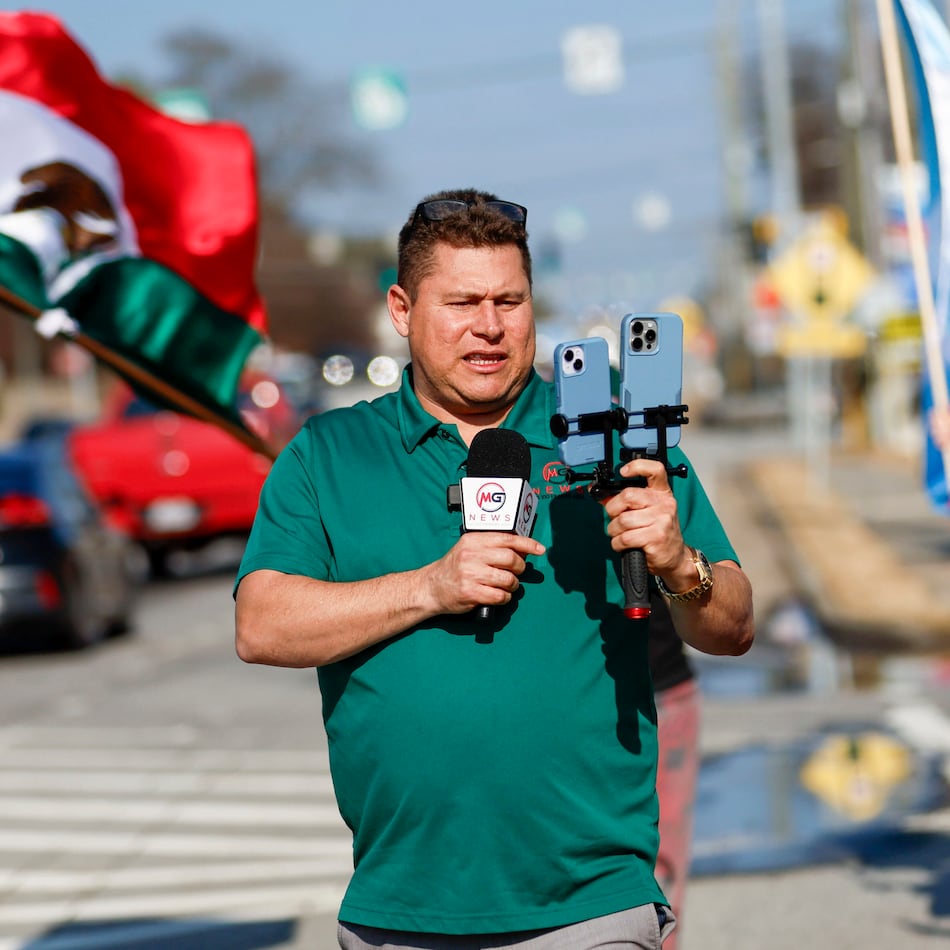Next to the St. Patrick’s Day Parade, the Picnic in the Park is Savannah’s most popular community event.
The annual fall orchestra recital at Forsyth Park draws 20,000 people (at least when it doesn’t rain). Since the 1980s the gathering has been a garden party writ large, with families, groups of friends and even businesses donning their Sunday best and decorating their spaces with linen-draped tables topped with candelabras and bone china along with flower glow-ups.
For the band, the Savannah Philharmonic, the event is a front porch marketing tool. Admission is free and exposes the area’s more casual classical music fans to the highly regarded professional orchestra.
This October, though, “the Phil” as it is known won’t play the Forsyth Park show. Because the orchestra, which loses significant money on the concert, doesn’t have to.
The Savannah Philharmonic says it is enjoying unprecedented growth with season ticket sales for the series that starts in September maxing out in just eight weeks — 13 weeks faster than two seasons ago. The orchestra expects to sell out the remaining tickets, or about 250 per show, in advance of the concert dates.
The success comes in spite of shifting entertainment options and musical tastes that would seemingly undercut interest in traditional symphony orchestras.
Other orchestras across Georgia, in markets big and small, also say they are enjoying audience growth and better finances after concerts screeched to a halt during the COVID-19 pandemic.
Many are experimenting more than before. While long-dead composers like Beethoven and Tchaikovsky remain staples, there’s also a push toward female and contemporary composers, even K-pop, to draw new and younger audiences. They’re also expanding community outreach, including free concerts in parks.
There are signs of “a bit of a resurgence” nationally in selling subscriptions and many symphonies are enjoying “slightly higher” audience sizes than before the pandemic, according to Simon Woods, CEO of the League of American Orchestras, an umbrella group. “I’m generally hearing people feeling positive about what is happening with audiences,” he added.
Several rely heavily on partnerships with local universities and wealthy individual donors to cover costs and keep ticket prices down. Musicians typically play in more than one symphony and often hold other jobs to make the math work.
Cuts to federal funding through the National Endowment for the Arts is stoking anxiety. But federal outlays typically only represent around 5% of funding, unlike in Europe, where Woods says it’s closer to 80%.
Although some symphonies have folded since the turn of the century, like in Gainesville, other cities such as Savannah and Macon have seen their orchestras reopen after shuttering. Most have been around for decades. One traces its beginning to before the Civil War.
Nearly 200 years after Beethoven’s death, there are more than 15 classical orchestras crisscrossing the state — from Valdosta to Columbus to Dahlonega. Most have budgets in the hundreds of thousand of dollars, a far cry from the Atlanta Symphony Orchestra’s $43 million annual wallet but enough to stage several performances a year.
“They are generally resilient,” said Woods. “There’s a long history of orchestras going out of business and then coming back.”
The Atlanta Journal-Constitution reached out to several orchestras across Georgia. Here’s what they shared.
Albany Symphony Orchestra
After the pandemic, the Albany Symphony Orchestra’s board made “the bold decision” to offer its concerts for free, boosting attendance from pre-COVID levels and drawing in new faces, according to Claire Fox Hillard, the music director and conductor.
The symphony just completed its 61st season and now offers concerts at “no charge, with a suggested donation of $15” to ensure performances are accessible to everyone.
It continues to try new things. Some concerts are shorter without intermission and have moved to less-busy weekdays like Tuesday. Most also start earlier, at 6:30 p.m., to accommodate hectic daily life “and the ability to go to dinner after concerts,” said Fox Hillard, who has been music director for 37 years.
This past season, a smaller orchestra performed during a candlelight dinner at a local country club. This coming season, the symphony plans to add some smaller performances in private homes.
All the musicians are paid and come from a 90-mile radius of Albany: Columbus, Tallahassee, Valdosta and Macon. The orchestra has 65 to 70 musicians, but uses fewer in some concerts.
The orchestra performed in the Albany High School Auditorium until 1990, when it moved into the newly renovated historic Albany Municipal Auditorium. The gala concert featured Ray Charles, who was born in Albany.
Athens Symphony
The Athens Symphony is different from many of its peers in Georgia — its concerts are free and it typically doesn’t pay its musicians.
Roughly 80% of funding comes from individual donations, including about a dozen sponsors who give $2,500 annually.
The orchestra and chorus is typically around 90 to 115 people, mostly from Athens but also neighboring Jackson and Oconee counties and as far north as Gainesville and Toccoa.
“They do it for the love of music and their commitment to provide it,” said executive director Dick Hudson.
The Athens Symphony’s first concert was in 1979 at Clarke Central High’s auditorium, where most concerts were held until moving downtown to the Classic Center in 1996.
Programming has remained steady for a long time — spring concert in March, pops concerts in April, fall concert in November, Christmas shows in December. The seasonal shows “sell out” with roughly 2,000 in attendance and the pops shows are held in a smaller room with about 1,000.
Hudson has served as executive director for 12 years and been involved for 20. He said the audience skewed older when he first got involved, but in recent years they have made progress in drawing university students for “a cheap date,” and families with young children, especially for the Christmas show.
Atlanta Symphony Orchestra
The Atlanta Symphony Orchestra, by far the state’s biggest, is changing its tune in the 2025-26 season with a diversity push.
After a six-concert Beethoven Project and performances spotlighting other famous — and long-dead — composers in 2024-25, the upcoming season includes such mainstays as Schubert, Bach, Mahler and, yes, Beethoven.
But the new season, its 81st, starts in September and more prominently features living, nonwhite, female composers. Performances of living composers will triple to 12 from last season, including 10 compositions from women and nonwhite composers.
The symphony is “very healthy” financially, with “record” classical revenue this past year and “particularly strong” subscriptions, according to Ashley Mirakian, vice president of marketing. It expects to balance its budget an 11th straight year and boasts a roughly $110 million endowment. Corporate sponsors Boston Consulting Group and Delta Air Lines have contributed more than $1 million.
Audiences have returned to prepandemic levels, and 13,000 new patrons saw the orchestra perform classical, holiday and family performances. Atlanta Symphony Hall seats a bit more than 1,700 and it’s 88% full for classical concerts.
The symphony has 88 professional, paid musicians and a volunteer chorus of more than 180 musicians and youth programs, including the Atlanta Symphony Youth Orchestra.
It is expanding its free concerts this year. That includes a planned concert this fall at Alpharetta’s Ameris Bank Amphitheatre with 10,000-plus capacity. It is also continuing its tradition of a free concert at Atlanta’s Piedmont Park, which often draws more than 10,000 people, and will be held in April.
Augusta Symphony Orchestra
Maestro Dirk Meyer proudly describes today’s Augusta Symphony Orchestra as “not your grandmother’s orchestra.” The proof, executives say, is in the audience.
The symphony moved into a restored home, the 1,284-seat Miller Theater downtown, in 2018 and restructured its performance schedule by adopting a season series format. Since the lifting of pandemic restrictions, it has evolved its programming and seen audience growth.
The changes start with Meyer, the German-born conductor who’s led the orchestra since 2017. He programs concerts that feature classical favorites such as Mozart and Beethoven along with contemporary composers in the same show. Film showings, with the Augusta symphony performing the movie’s score, are popular new additions.
And this summer, the symphony will perform a July Fourth show, complete with fireworks, at a minor-league baseball stadium, SRP Park.
“As much as a symphony can seem like something of past generations, when we look at the arts landscape in our community, we remain an anchor of it,” said Katherine Bonner, the orchestra’s development director.
The pay-per-performance orchestra contracts with professional musicians from the Carolinas and across the Southeast. Several players have performed with the Augusta ensemble for more than 30 years, a testament to the culture the orchestra has built in its seven-decade existence, Bonner said.
The Miller Theater, originally an Art Moderne movie theater built in 1940, was donated by Augusta philanthropist Peter Knox IV. A $24 million rehab led to a reopening that ended a long history of playing — and paying for — various performance halls. The symphony played 13 different theaters before to moving into the Miller.
“The Miller changed everything for the symphony,” Bonner said.
Columbus Symphony Orchestra
Many an orchestra can claim inspiration from the great German composer Felix Mendelssohn. Columbus is one of the few with roots to the classical music icon.
The Columbus Symphony Orchestra was founded in 1855 by a student of Mendelssohn’s, Herman S. Saroni. That makes it the oldest orchestra in Georgia and second oldest in the United States, behind only the New York Philharmonic.
In its most recent season, single concert ticket sales per show outpaced subscribers, a likely sign that new patrons were “trying us out,” said executive director Kern Wadkins.
The symphony has piqued interest by embracing a more personal approach. It opens each final preconcert rehearsal to the public and is reimagining the concert intermission, with conductor George Del Gobbo and several musicians mingling with the patrons at a short cocktail reception featuring food and beverage selections tied to the geographic region of the music.
A connection to Columbus State University’s Schwob School of Music, with its nationally recognized classical music curriculum, means frequent guest appearances by world-class artists who teach at the school as well as outstanding students.
The symphony performs in a picturesque concert hall, the RiverCenter for the Performing Arts, located near the Chattahoochee River downtown. The orchestra typically draws crowds of 800 to 1,200 patrons to the 2,000-seat theater, according to Wadkins.
LaGrange Symphony Orchestra
After pulling the plug on concerts during the pandemic, attendance for the LaGrange Symphony Orchestra “has rebounded well,” surpassing pre-COVID levels the past two seasons. The uptick is boosted by more people younger than 40, according to Executive Director Raylene Carter. Season ticket sales are up 39% from two years ago.
Carter quotes the symphony’s maestro, Richard Prior, for the continued draw of classical concerts: “People do not come to the symphony to just hear music because there is a world of wonderful, recorded music available. People come to the symphony to watch musicians bring music to life in front of your eyes.”
The symphony says it does not have a huge financial cushion and is concerned about threatened federal cuts, but it has no outstanding debts. It partners with local businesses for sponsorships and private donations have increased in recent years. Some foundation support has decreased, as have government grants. It also teaches string lessons to youths and adults.
It has struck up a partnership with Troup County schools, “Strings Attached,” an after-school weekly program with more than 400 students participating.
The orchestra just completed its 36th season. It performs five concerts each year plus four educational concerts, as well as a fall and spring youth symphony and string ensemble concert. It is looking at additional concerts in smaller venues, part of its “meeting people where they are” philosophy, according to Carter.
Many of the musicians, who are paid, come from Columbus and Atlanta, to supplement local talent. Some come from Alabama, Tennessee and Florida.
Macon-Mercer Symphony Orchestra
The Macon-Mercer Symphony Orchestra was founded in 2021, four years after the city’s previous symphony, around since the mid-1970s, went under.
The new orchestra, backed by individual donors and sponsors, has received major support from the Peyton Anderson Foundation, which, in 2021, pledged $300,000 as part of a five-year grant. The foundation has recently pledged an additional $500,000 to help fund five more years.
The orchestra performs at the Piedmont Grand Opera House in downtown Macon and has some 60 musicians, most of them scholarship cellists, violists, violinists and bassists from Mercer University’s McDuffie Center for Strings, a world-class conservatory. But a handful of the musicians, a dozen or so, are professionals from the Atlanta Symphony Orchestra’s woodwind, brass and percussion sections.
The Macon orchestra was founded by renowned violinist Robert McDuffie, a Macon native, who also helms his namesake McDuffie Center at Mercer. Julia Morrison, director of arts marketing at Mercer, said McDuffie “has found a way to really upend the symphony business model,” in part by combining accomplished student players from across the country with pros from Atlanta.
“We’re also doing quite well,” Morrison said of the orchestra’s viability. “It’s sort of been an amazing thing to build this new symphony. In 2021, I think it would have been a crazy idea to tell anyone around the country, ‘We’re starting a brand new symphony orchestra.’ But we have done a great job.”
The opera house in Macon seats about 1,000 people and the orchestra’s four-show seasons average about 825 concertgoers per performance.
The orchestra has increased its number of subscribers each year of its existence. It had 426 subscribers last season and nearly half have already renewed for the coming season.
“We have no music director, we have no executive director, we have no director of development, we don’t have an artistic administrator,” McDuffie said, noting that the Mercer strings faculty handles those roles.
“We’ve been able to prove you can put on a great product without so much overhead.”
Rome Symphony Orchestra
The Rome Symphony Orchestra trumpets its roots back to 1921.
“We are proud to be the oldest symphony orchestra south of the Mason-Dixon Line — affectionately known as ‘The Oldest Symphony in the South,’” conductor Jeffrey Dokken relayed in an email.
The symphony’s website cites an editorial in The Baltimore Sun from June 1923, which stated, “It was the first and only symphony orchestra in the South.”
Columbus traces its orchestra’s roots back much further, all the way to the 1850s.
Still, Rome has been making music long enough to fill a book — in fact, a book about its first 100 years was published in January.
Dokken described the symphony’s financial health as “currently stable” but that it would benefit from increased financial reserves. Its primary funding sources include season ticket sales, private donations, an annual fundraising event and government grants.
Leadership is concerned by the uncertain status of key government granting agencies just as it is trying to raise funds to hire a full-time executive director. In the meantime, Dokken and Lucy Coyle, the general manager, each juggle two roles.
The symphony has between 150 and 200 season ticket holders, and attendance varies between 350 to 600 people, according to Coyle. Dokken says musicians, who are paid between $75 to $125 per service, come from metro Atlanta, Chattanooga, Huntsville and Rome.
Savannah Philharmonic
The Savannah Philharmonic is building toward a crescendo at an opportune time — the city has announced plans for a major renovation to its 2,500-seat performing arts hall, the Johnny Mercer Arena.
The symphony’s recently concluded 2024-2025 season marked the third straight where it sold out every show at its current home, the 1,237-seat Lucas Theatre. It pulls talent from along the East Coast, including musicians from as far away as New York City.
The orchestra is relatively new, playing its first concert in 2009 — six years after the Savannah Symphony Orchestra went bankrupt due in large part to management issues. That history exacerbated concerns — from local music lovers and orchestra musicians — when the Philharmonic announced the cancellation of the Picnic in the Park event.
Credit: Courtesy of Savannah Philharmonic
But Amy Williams, the executive director, sent a note to the musicians highlighting the Philharmonic’s growth, which includes expanding a matinee series on concert days, and trumpeting the success of what the Philharmonic board calls an “innovation fund.” The capital campaign aims to raise $2 million to expand the orchestra’s numbers once the Mercer Theatre renovation is completed.
The Mercer makeover is likely to begin in 2026, provided voters provide funding by passing a sales tax referendum on the November ballot.
“We want to be in position to fill a larger stage in the expanded” theater, Williams said. “Every artist seat will be filled with a national search. And we want the ability to fund really high quality guest artists.”
To make up the marketing value lost by not doing the Picnic in the Park, the Philharmonic is expanding its “Phil the Neighborhoods” series. Launched in 2022, these concerts feature a small group of musicians playing in community parks around the Savannah area. The shows draw between 400 and 800 attendees and there is waiting list of neighborhoods eager to host an event.
City leadership supports the Philharmonic’s strategy. The municipal budget includes $65,000 for the orchestra, $48,000 of which was designated for the Picnic in the Park. The city will not withhold those funds with the cancellation of the Forsyth concert.
Valdosta Symphony Orchestra
The Valdosta Symphony Orchestra keeps costs down by partnering with Valdosta State University, which shares its nearly 750-seat concert hall and music department’s faculty and resources.
The symphony, formed in 1990, has watched its endowment roughly double to $4.2 million in the last few years.
“It’s a challenge, don’t get me wrong, but we’re in good shape,” said Doug Farwell, a VSU professor of trombone who performs in the symphony and serves as its executive director.
The orchestra has five subscription concerts and three youth concerts a year. In the most recent season, audiences came from 50 cities across 10 states. Many who fill the seats are “pretty gray-haired,” in their “60s, 70s, 80s,” Farwell added.
The orchestra is also making efforts to draw younger crowds. A Halloween concert last October included a cosplay competition and music from movies such as “Jaws,” “Psycho” and “Night on Bald Mountain.”
It doesn’t shy away from older and more traditional fare, like at the “Blue Jeans and Beethoven” youth concert in February.
“A lot had not heard (Beethoven) before. It’s new to them,” and very well received, Farwell said.
The South Georgia String Project offers an after-school music program where children can learn to play string instruments at a low cost.
Musicians get paid $450 to $750 each for concerts — plus hotel for those traveling from as far away as Sarasota, Florida, and Charleston, South Carolina. When it comes to orchestras with smaller budgets and fewer performances, musicians often play in three or four other cities, according to Farwell. Some supplement their income by doing sound work in Georgia’s large movie industry.
The orchestra, taking a page out of Atlanta and Savannah’s playbook, plans to give a free outdoor concert next year in a city park to coincide with the July Fourth holiday weekend, complete with a light show.
Other orchestras around Georgia
Metro Atlantans have more than one option. In addition to the Atlanta Symphony Orchestra, the Georgia Symphony Orchestra in Marietta is the next largest, followed by the Johns Creek Symphony Orchestra, the DeKalb Symphony Orchestra and the Gwinnett Symphony Orchestra.
The Georgia Symphony Orchestra is readying for its 75th season after performing 12 concerts in front of more than 11,000 patrons this past year. Some 330 students from 14 different counties completed its youth orchestra program. Johns Creek’s symphony opened last season with a free “Classical K-pop” concert of orchestral arrangements of Korean popular music hits.
The North Georgia Chamber Symphony in Dahlonega bills itself as a “mostly professional orchestra.” It takes its music on the road, offering free concerts this past spring at a Gainesville church and on college campuses in Young Harris and Waleska.
The Coastal Symphony of Georgia on St. Simons Island has scheduled four concerts for its upcoming 43rd season. The symphony’s professional musicians perform “new compositions and favorites from the Old Masters” under the guidance of Michelle Merrill, the music director and conductor, who “encourages us to listen to classical music in new ways,” according to its website.
Several other youth orchestras and smaller ensembles are spread across the state.
Keep Reading
The Latest
Featured







